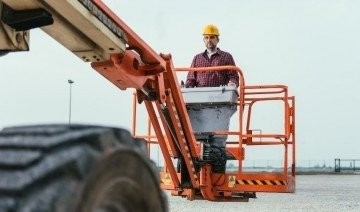{article.name}
Using a Lift for Winter Projects

- Share this:
- Share on Facebook
- Pin on Pinterest
- Tweet on Twitter
Lifts can be more than simply useful for winter projects, they can be essential equipment to complete different jobs safely and easily. But which lifts are best for which projects, and how can you use them most effectively in challenging winter weather?
Types of Lifts
There are many different aerial work platforms – lifts – that can be used for a variety of projects. Understanding the differences between lifts is critical so you can choose which one will work best for your needs.
- Cherry Picker – The most common type of lift, a cherry picker has a small bucket on a vehicle boom to lift 1-2 workers up for aerial access. This is a good choice for simpler projects.
- Personnel Lift – Another simple design, a personnel lift is a mechanical ladder that can lift one person straight up for straightforward projects.
- Articulating Boom Lift – Similar to a cherry picker, this lift has a double-jointed boom that offers more flexible positioning and rotation for jobs that require more aerial work.
- Telescopic Boom Lift – While this lift does not have as much position flexibility, it can reach taller heights than other types of lifts, and can generally accommodate 1-2 people.
- Scissor Lift – This accordion-style lift can easily heft several workers or heavier equipment, but cannot usually reach the heights of boom lift. These lifts are popular for indoor projects.
- Towable Boom Lifts – Tow-behind lifts come in different sizes and styles and are great for smaller scale projects of different heights, though their specifications vary.
Which lift you choose will depend on the type of project you have planned, what height you need to reach, and how many people must work at that height.
Winter Projects Using Lifts
There are a number of winter projects that can be easier to accomplish with the appropriate lift. Typical winter projects that often use lifts include…
- Trimming trees or branches that may be damaged by snow and ice before they can collapse on a roof or fence, causing structural damage.
- Hanging holiday lights or decorations, or removing decorations after the holidays. This can include outdoor lights on houses and trees, or indoor decorations on vaulted ceilings.
- Washing windows to improve winter light, which can combat seasonal affective disorder as well as winter-induced depression.
- Repairing or maintaining electrical lines, transformer boxes, and other elevated utilities, particularly if junctions are vulnerable to ice and snow buildup.
- Replacing or redesigning lighting options in rooms with high, difficult-to-access ceilings, or outdoor security lights on high rooflines.
- Roof repair when icy surfaces make accessing the roof more dangerous. Snow removal from challenging roofs can also be easier when using a lift.
- Painting tall surfaces indoors or outdoors when such work can be effectively completed during the winter months.
- Safety inspections of chimneys, roofs, windows, and other structural elements after winter storms or when problems may be detected in any season.
While larger lifts are generally designed for outdoor use only, smaller lifts can be useful for indoor projects that are easy to complete during the winter months.
Tips for Using a Lift for Winter Projects
Whether lifts will be used indoors or outdoors during the winter, it is important to follow proper safety protocols and procedures to ensure efficient operation and worker safety. Before using any lift, read the operating instructions carefully and invest in the proper training if necessary. More tips for safe winter use of lifts include…
- Ensuring the surface the lift is on is stable and free of ice. Similarly, look for soft soil, ice heaving, or other uneven surfaces that could destabilize a lift and cause dangerous accidents.
- Take care that the lift’s power source and any connecting cables, as well as electrical controls, are free of moisture that could cause shorts or sparks.
- Keep the lift properly lubricated with cold weather waxes, oils, or other lubricants specially formulated for low temperatures, or the lift may seize up in extreme cold.
- Check the tire pressure before use to be sure the inflation is within the proper range for safe use and equipment stability.
- Clean fuel filters regularly to ensure smooth and efficient operation, particularly when the equipment may struggle in low temperatures.
- Keep work surfaces, including the lift buckets and platforms, ice-free for worker safety and to minimize slip hazards.
- Allow the lift adequate time to warm up thoroughly so fuel and oil can circulate properly, remembering that it is natural for the lift to work more slowly in extreme cold.
- Dress appropriately for using a lift in winter, bearing in mind that work conditions can be much colder the higher the work platform is elevated.
By choosing the proper lift for winter work and taking the necessary safety precautions for using a lift in low temperatures or snowy conditions, you can easily manage winter projects that need an elevated work platform or height accessibility. Lifts aren’t just for summer use, and if you use them safely, you can continue working on winter projects at any height you need.
© 2025 Grand Rental Station of Hampton Roads, VA. All rights reserved.
Serving the Hampton Roads Area
Driven by New Media Retailer

Comments